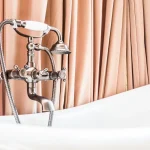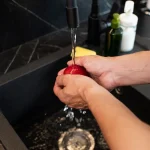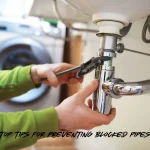When I first started tinkering with home plumbing, I remember standing in the aisle of my local hardware store, confused by the letters stamped on the pipes and fittings. FIP, MIP, NPT—what do these all mean? If you’ve found yourself asking, “What does FIP mean in plumbing?” you’re not alone! This article is designed to make everything clear and simple, so anyone—even a fifth-grader—can understand.
What Does FIP Mean in Plumbing?
FIP stands for Female Iron Pipe. In plumbing, “FIP” describes a type of fitting, specifically one with internal or female threads. These threads are found inside the opening, allowing you to screw a matching pipe with external threads (male threads) into it.
-
Female = Threads inside
-
Iron Pipe = Standard size for plumbing pipes and fittings
If you see FIP on a pipe or fitting, it means it is ready to accept a pipe or connector that has threads on the outside.
Real-Life Example
Last year, my neighbor asked me to help fix a leaky outdoor spigot. When I went to buy the replacement, the instructions said, “FIP connection required.” If I didn’t know what FIP meant, I might have bought the wrong part!
Why Does FIP Matter?
Knowing what FIP means helps you choose the right parts, avoid leaks, and finish your plumbing jobs faster. It also saves you frustration—no one likes a trip back to the store because a piece didn’t fit.
How FIP Is Used in Your Home
-
Shut-off valves: These often have FIP threads so you can screw on supply lines.
-
Water heaters: Many connections use FIP fittings for easy replacement.
-
Faucets and sinks: FIP threads are common for water supply hookups.
Once, my aunt tried to install a new kitchen faucet and wondered why the pipe wouldn’t “catch” the threads. She had mixed up an FIP and MIP fitting—a common mistake!
What’s the Difference Between NPT and FIP?
This is a super common question, especially for anyone new to plumbing.
-
NPT stands for National Pipe Thread. It’s a thread standard—sort of like the shape of the screw thread.
-
FIP stands for Female Iron Pipe. This describes the gender and style of the fitting.
FIP threads are almost always NPT threads, which means a “FIP fitting” typically has internal threads that match the NPT standard.
In simple words:
-
NPT tells you about the shape and size of the threading.
-
FIP tells you it’s a female fitting with internal threads that (usually) use the NPT standard.
Why Do People Mix Them Up?
It’s normal to see plumbing supplies labeled as “1/2” FIP” or “1/2” NPT FIP.” Both mean the same: it’s a half-inch female fitting with NPT threads.
I once spent twenty minutes searching a hardware aisle for an “NPT” fitting, not realizing the part marked “FIP” was just right. It’s all about learning the lingo!
What Does FIP Mean on a Supply Line?
If your toilet or sink’s water supply line says “FIP,” this tells you how the connector attaches to the shut-off valve or fixture—it screws onto (not inside) another pipe or fitting, thanks to the female threads.
How To Spot FIP on Supply Lines
-
Look at the ends: FIP ends have threads inside the nut.
-
Feel the threads: If you can’t screw something into it, but instead onto it, it’s FIP.
This is especially important when replacing water supply hoses. Once, my cousin bought a new washing machine hose labeled “FIP x FIP.” He didn’t know what this meant and almost returned it, but it was, in fact, the exact one he needed—FIP on both ends to attach to both his machine and the wall valve.
What Does MIP and FIP Mean in Plumbing?
These acronyms go hand-in-hand.
| Abbreviation | Full Name | Threads Location | Typical Use |
|---|---|---|---|
| FIP | Female Iron Pipe | Inside (female) | Fittings, valves, elbows |
| MIP | Male Iron Pipe | Outside (male) | Pipe ends, nipples |
-
FIP: Female, threads on the inside—accepts male parts.
-
MIP: Male, threads on the outside—screws into female parts.
You put a MIP pipe into a FIP fitting—like a peanut butter + jelly sandwich.
Anecdote
When I helped my grandpa install a new outdoor hose bibb, he sent me inside for “a half-inch MIP to three-quarter FIP elbow.” I felt like I was in a secret club once I realized what those codes meant!
What Does FIP Mean? (In Case You’re Short on Time!)
-
FIP = Female Iron Pipe: An internal-threaded, female fitting.
-
Used to connect with a male (MIP) fitting with matching external threads.
-
Common on home plumbing: valves, elbows, faucet connections.
Unique Insights and Handy Tips
1. FIP Is Not Just for Iron
Even though it says “Iron Pipe,” FIP fittings can be made from brass, copper, PVC, or even stainless steel—not just iron.
2. Always Use Plumber’s Tape
When joining MIP and FIP pipes, wrap plumber’s tape (PTFE tape) around the MIP threads. This gives a better seal and helps prevent leaks.
3. Hand Tight + Small Wrench Finish
Over-tightening FIP connections can cause cracks or leaks, especially on plastic fittings. Hand-tighten first, and then give it just a snug turn with a wrench.
4. Don’t Cross-Thread
If the pieces don’t fit together smoothly, stop! Never force FIP and MIP threads. Back off, try again. Cross-threading damages the fittings and causes leaks.
5. Not All FIP Fittings Are NPT
Some imported or specialty plumbing supplies use different threading standards (like BSP for British sizes). Always check you’re using the right fittings—NPT (U.S.) and BSP (British) don’t mix!
Table: Quick Guide to Plumbing Fitting Types
| Fitting | Threads Location | Example Label | What It Connects To |
|---|---|---|---|
| FIP | Inside | 3/4″ FIP | MIP pipe (outside threads) |
| MIP | Outside | 1/2″ MIP | FIP fitting |
| NPT | Outside or inside | 1/2″ NPT | Standard U.S. plumbing |
| BSP | Outside or inside | 1/2″ BSP | Usually UK/AU hardware |
More Anecdotes from Real Jobs
Mixing Up FIP and Compression Fittings
I once helped a friend install a new shut-off valve. He picked a FIP fitting when he needed a compression type. Not all supply lines are threaded! Try to match the valve and pipe type exactly, or they won’t seal right.
The MIP/FIP Dance
A local plumber told me, “Every new apprentice ends up asking, ‘Wait, is this the inside or the outside?’” It’s a rite of passage in plumbing circles!
Simple Plumbing Tips for Homeowners
-
Label Your Parts: Use masking tape and a pen to mark FIP or MIP when you dismantle plumbing; it saves confusion later!
-
Bring Old Fittings to the Store: If in doubt, take both fitting ends to the store so the expert can match them up for you.
-
All About the Seal: Always check for leaks after you finish a job—better to spot a drip now than water damage later.
Recap: FIP in the Real World
-
FIP means the threads are on the inside.
-
Used everywhere in home plumbing: sinks, showers, water heaters, garden spigots.
-
Match FIP with MIP for a proper connection.
-
Always use sealant or tape for leak-free joints.
-
If a connection feels wrong, don’t force it—double-check!
-
Not all FIP threads are the same; U.S. and British sizes don’t mix.
FAQs for Homeowners
What Is the Main Use of FIP in Plumbing?
FIP fittings are used wherever you need a strong, reusable, and leak-proof threaded connection. They make swapping out parts like valves, faucets, and hoses much simpler.
Is FIP Just for Professionals?
Not at all! Many home repair projects involve FIP/MIP connections. Knowing what they mean can help you tackle basic plumbing jobs with confidence.
How Do I Know If a Fitting Is FIP?
-
The threads are inside the fitting.
-
The part is labeled FIP, usually stamped or printed on the packaging.
-
It’s designed to accept a male-threaded piece.
Final Thoughts
Understanding FIP in plumbing takes out a lot of the guesswork and helps you feel more at ease, whether you’re fixing a leaky pipe or taking on your first DIY project. Next time you’re in the store or under a sink, you’ll know exactly what those confusing letters mean.
My advice? Don’t be afraid to ask the staff at the hardware store for help. Even seasoned pros check the letters and double-check their parts. In plumbing, a little knowledge goes a long way to saving time, money, and headaches!










